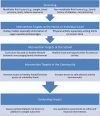Lifestyle interventions to reduce diabetes and cardiovascular disease risk among children
- PMID: 25344792
- PMCID: PMC4209242
- DOI: 10.1007/s11892-014-0557-2
Lifestyle interventions to reduce diabetes and cardiovascular disease risk among children
Abstract
Diseases once associated with older adulthood, type 2 diabetes and cardiovascular disease, are increasingly diagnosed in children and adolescents. Interventions designed to assist adults in modifying dietary and physical activity habits have been shown to help prevent the development of type 2 diabetes and cardiovascular disease in adults. Given the unfortunate rise in both of these diseases in pediatric populations, it is increasingly important to begin prevention efforts in childhood or prenatally. There is strong empirical support for utilizing lifestyle interventions to prevent these diseases in adults; it is not clear whether the same holds true for pediatric populations. The present review examines lifestyle management efforts to prevent type 2 diabetes and cardiovascular disease in children across socioecological levels. Recommendations are made for expanding the traditional focus of lifestyle interventions from dietary and physical activity behaviors to target additional risks for these diseases such as smoking and depression in youth.
Conflict of interest statement
Dorothy J. Van Buren previously worked as a co-investigator and therapist for Dr. Denise Wilfley on the COMPASS childhood obesity grant (2009–2011) and as a behavioral scientist on the TODAY pediatric diabetes grant project under the direction of Dr. Denise Wilfley (2003–2011). Dr. Van Buren is also a member of the Obesity Society, Pediatric Section; the Association for the Advancement of Cognitive and Behavioral Therapies, Obesity and Eating Disorders Special Interest Group; and the Society for Behavioral Medicine.
Tiffany L. Tibbs previously worked as a treatment consultant for Dr. Denise Wilfley for a COMPASS childhood obesity grant (2009–2011) and as a faculty member on the TODAY pediatric diabetes grant project under the direction of Dr. Denise Wilfley (2003–2007) and has worked as an employee and consultant on several NIH grants that were awarded to Washington University School of Medicine.
Figures
References
-
- Imperatore G, Boyle JP, Thompson TJ, Case D, Dabelea D, Hamman RF, et al. Projections of type 1 and type 2 diabetes burden in the U.S. population aged <20 years through 2050: dynamic modeling of incidence, mortality, and population growth. Diabetes Care. 2012;35(12):2515–20. doi: 10.2337/dc12-0669. - DOI - PMC - PubMed
Publication types
MeSH terms
LinkOut - more resources
Full Text Sources
Other Literature Sources
Medical


